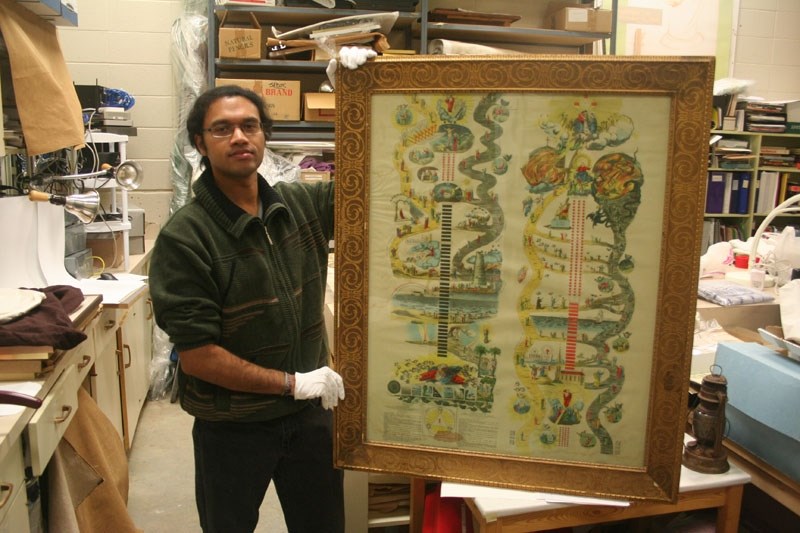“It’s one of the great founding documents of Western civilization, and its significance can’t be overstated.”
These are strong words about the Magna Carta from Jeff Morrison, the Chief Crown Prosecutor for the Edmonton Rural area encompassing a large swath of territory north of Edmonton, but they’re undoubtedly justified.
A 700-year-old copy of the 800-year-old document will be on display at the Alberta Legislature until the end of December, and the exhibit is free to the public.
The document was created and signed to settle a dispute between King John of England and a group of rebellious nobles, and enshrined countless rights we might take for granted today like an elected government and the right to a fair trial by a jury of one’s peers.
Not to mention that fact the 700-year-old document dates back to well before European settlers came anywhere near St. Albert.
The Magna Carta has had a significant impact on the legal system we have in Canada and the rest of the English-speaking world, enshrining the basic rights and protections we enjoy.
“For the first time in Western civilization, a document prescribed the right of kings and elevated the rights of the people within a system of the rule of law,” Morrison said.
While the ancient Greeks and Romans had a system of democracy, the fall of the Roman Republic 2,000 years ago meant emperors and kings would rule Europe unchecked for 1,200 years.
The Magna Carta also provided a framework for the legal system as it continues to exist in English-speaking countries, enshrining several rights we now see as self-evident.
“One of those, most importantly, is the right to a trial by a jury of one’s peers,” Morrison said. “That is, again, a very important idea.”
This is not to say the document was warmly embraced over the centuries. Oliver Cromwell, the infamous Lord Protector of England, is reported to have referred to the document as the “Magna Farta” to show his disdain.
But Morrison notes with the Glorious Revolution in 1688 and the creation of the 1689 Bill of Rights, the principles in the Magna Carta were further reinforced in order to protect the people and those elected to make decisions on their behalf.
“It expanded the concept of the Magna Carta to include Parliamentary sovereignty,” he said. “This is a fascinating evolution in our entire civilization, let alone our jurisprudence.”
St. Albert MLA Marie Renaud has already been to see the exhibit, and said she appreciates being able to see such a significant part of history so close to home, and the impact it has had on her own job.
“It’s given us all the ability to know we all have rights. It’s not just the lords and ladies and the noble class, it’s all of us,” she said. “It’s the reason we’re all here in the legislature or in the assembly, that elected people are making decisions. It’s pretty amazing.”
She said the exhibit itself provides a great deal of context for the document, with interactive components that help illustrate how far ahead of its time it was. The Canadian Charter of Rights and Freedoms, for example, is just 40 years old.
“To have this document so close to St. Albert is an opportunity not to miss,” Renaud said.
Another St. Albertan who will not miss the opportunity to see the exhibit, not surprisingly, is Musée Heritage Museum archivist Vino Vipulanantharajah.
He said as an archivist he relishes the opportunity to see something with such a significant history; by comparison, the oldest artifact featuring ink on paper at his museum dates back to 1885, about 670 years after the Magna Carta was signed.
The copy of Father Lacombe’s catechism, a pictorial ladder showing the path up to heaven or down to hell, was created in part to explain Catholic ideas to the native population of the area, who weren’t necessarily all receptive to the message.
“It’s probably one of the things he’s most well-known for in the world, this catechism ladder he created,” he said. “Pope Pius IX saw it and asked to reproduce it, and it spread.”
As for why one should see the Magna Carta itself rather than just looking at a digital copy of it, Vipulanantharajah said the history and feel of the physical artifact is lost in the process of digitization.
He used the museum’s copy of a document from 1982 when the Canadian Constitution was patriated as an example. The copy shows a red blob of ink on it, which an art student put on the original as a form of protest.
Likewise, the copy of the Magna Carta on display in Edmonton features not just the text of the document, but the small imperfections and signs of wear that give it character.
“It’s part of the story now,” he said. “The digital image doesn’t always give you perspective the original does.”
The exhibit at the legislature grounds is open until Dec. 29.




